The Big Kid's Muscle-Up
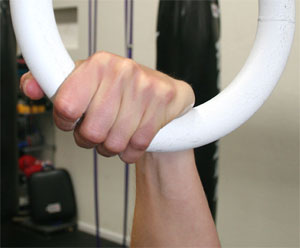
The muscle-up has become a standard measure of an individual's development in the realm of real fitness (in contrast to the more common measure of the loading of a supinating dumbbell concentration curl). There is a large, bold line separating the haves and have-nots, and those have-nots invest a great deal of time and energy into the pursuit of their monumental first muscle-ups. A very generous definition of the movement—simply getting your center of mass from under to over a pair of rings—seems to have become an acceptable standard. This is unquestionably an accomplishment of which to be proud, but continuing progress demands the development of a strict—or strict—muscle-up.
The rudimentary variation of the muscle-up excludes full extension at both the beginning and end of the movement—the two most difficult points in terms of strength. In addition, epic kips are employed. To clarify, the kip itself is not necessarily problematic—it's an excellent tool for helping develop the pull-up, for example, and has numerous benefits of its own. But in the case of the muscle-up, the kip is used to effectively bypass the transition from under to over—the most technically difficult aspect, and the development of which is necessary for a strict muscle-up. That being the case, continued performance of rudimentary muscle-ups without additional specific work prevents the development of the strict muscle-up.
Rudimentary Muscle-up vs Strict Muscle-up
Power Grab with a False Grip
The idea of optimizing power generation is a popular one—that is, performing a maximal amount of work in minimal time. In this context, the rudimentary muscle-up has found a welcoming home. The elimination of two inches each at the initial and end stages of the movement results in a relatively small reduction in total work because of the movement's unusually great range of motion—more than double that of a squat or pull-up. A reduction of 4 total inches of travel will reduce the work of a pull-up by over 17%, but will only reduce the work of a muscle-up by 9%.
More importantly, because time has a greater influence on power than the distance of travel, the reduced time for completion for the kipped muscle-up results in an enormous increase in power despite the reduction in work resulting from the reduced travel. A muscle-up with a range of motion shortened by 4 inches and performed in 2 second results in greater than 50% more power in comparison to a full range of motion muscle-up completed in 4 seconds.
What this means is fairly simple: depending on your individual objectives, the rudimentary muscle-up may have a place in your training. If your goal is achieving the highest power output possible—for example, for metabolic conditioning—clearly the rudimentary muscle-up is the better choice: it has the potential to deliver far more power than the strict muscle-up because of its high speed of execution.
So What's the Problem?
It's mathematically demonstrable that a muscle-up performed with greater speed, even with a reduced range of motion, results in far greater power output than a strict, full range of motion muscle-up, which by its nature requires more time to execute. So does it make sense to spend time and effort developing a strict muscle-up? That depends on your individual goals (which I assume confidently that you have clearly defined). If your only goals don't extend any further than repeatedly and indefinitely getting your metabolic rocks off, the rudimentary muscle-up will suffice. If, however, you have greater athletic aspirations, the inherent limitations of the rudimentary muscle-up will be an important consideration in your programming.
Once you've achieved a rudimentary muscle-up, performing the movement regularly will undoubtedly result in the ability to perform more and more of the same movement. Eventually, however, the stimulus will not be adequate for continued strength gains (unless you're continuously gaining bodyweight). Imagine deadlifting the same load for ten years—day one, that load may allow you to perform only a single rep. Eventually you'll likely be able to perform several successive reps—some day, you may be able to 100. But the ability to perform 100 reps of a given movement with given a load does not translate into the ability to lift a significantly greater load with that same movement (think Jazzercise practitioners—they can move a two-pound dumbbell about a million times). Beyond a certain threshold, strength development is replaced by local muscular endurance development. To continue developing strength, the resistance must be increased incrementally. This is the most basic concept of resistance training—progressive overload.
This idea results in a fitness progression resembling graphically a stair-step: that is, time must be spent developing a foundation of strength, then building on that strength base a greater degree of metabolic conditioning and stamina. Failure to develop the strength base unavoidably results in eventual stagnation.
The Point, Finally
All of that is simply to say that in order to continue to progress, the development of a strict muscle-up is a necessity—and the repeated performance of the rudimentary muscle-up will never produce this result. Just like you wouldn't (I hope) progress your deadlift though a spastic, limited range of motion, nor should you do so with your muscle-up; a requisite foundation for continued strength development in the movement is the development of the movement in its most precise form.
My personal recommendation is that people make learning the strict muscle-up a priority over achieving the rudimentary muscle-up—that is, they patiently develop both the requisite strength and technique for the strict movement instead of grasping for anything that even vaguely resembles it simply to have one more movement to throw into the metCon pool. The reasons are based on both motor learning and path-dependent transferability. It's very difficult to learn a new movement pattern that is very similar to an existing one: the transition movements of the two muscle-up variations are similar enough to cause neurological learning difficultly, but different enough that the movement pattern of the rudimentary muscle-up will not translate effectively to the strict muscle-up. And in terms of transferability, if you're capable of performing a strict muscle-up, you're without question also capable of performing a rudimentary muscle-up; the inverse, however, is clearly not true.
Developing the Big Kids' Muscle-up
Whether you have several rudimentary muscle-ups already or none at all, the progression to developing the Big Kids' Muscle-up is the same.
False Grip
Just about anyone will tell you the false grip is key number one for a muscle-up. If you're not yet familiar with the term, a false grip is the deep placement of the hand on the rings. A common mistake is gripping the ring on its side—this will result in an awkward support for the pressing portion of the movement. Be sure to place the false grip at the bottom of the ring—remember that this position should be the same you would use during a dip because that's exactly what you'll be transitioning into. Also, the use of chalk to keep the hands dry, particularly when performing multiple successive reps, will help immensely in maintaining the false grip.
Development: Perform static hangs with a perfect false grip. If you're unable to hang with your entire weight, support yourself with your feet initially and incrementally reduce the amount of support over time until it's no longer necessary.
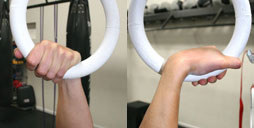
Beginning Extension
As discussed above, the rudimentary muscle-up avoids full arm extension and shoulder opening at the beginning of the movement, and for good reasons—this position is both the most difficult in which to maintain a false grip and from which to initiate a pull-up. Full extension requires the hands be pronated (palms facing forward)—this is necessary to fully open the shoulders.
Development: Practicing the beginning extension can be accomplished in the same way described for the false grip—they are of course conveniently linked.
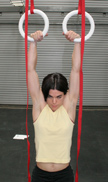
Transition
The transition of a strict muscle-up often seems far more complicated to many people than it actually is. Typically those who have the most difficulty learning it are those who are already capable of performing kipped muscle-ups, both because of the motor learning obstacles mentioned previously and the frustration that tends to develop when they abruptly go from being able to relatively easily get above the rings to repeatedly stalling below them.
The mechanics are simple—the elbows need to move from under to over the shoulders in order to transition from a pulling position to a pushing position. A common mistake is a staggered transition of the arms—"putting on a sweater." This allows the individual to partially unload one side in order to more easily move the corresponding elbow into position, which then allows them to support themselves at a higher elevation, making the transition of the second elbow shorter and easier. Not only does this look stupid, but it places the individual in a risky position from which it's easy to over rotate forward and do some potentially serious damage to a shoulder. Unlearning this habit is very difficult—the solution is to never develop it.
Learning the transition with barely adequate strength is difficult—this typically encourages a kip—sometimes subtle, more often not—to power through the sticking point. This is a mistake—as mentioned above, overpowering through the transition alters the mechanics enough to make the development of strict mechanics far more difficult. A much better option is to reduce the load to allow perfect technique practice.
Development: Lower your rings to a level at which you can comfortably grasp them with a false grip while seated on the floor, legs extended in front of you. In this case, don't worry about full extension—you're not working on developing that ability here and that extra effort will only take away from the practice of the movement on which we're focusing—but make sure to use the false grip.
From this position, pull the rings to below your armpits—keep them and your elbows as close to your body as possible—rotating them 90 degrees from the initially pronated hand position to a neutral one. At the peak of this pull, quickly flip your elbows back and up to a position above your shoulders. From here, press out, again keeping the rings as close to your body as possible and your elbows pointing backward.
If you struggle to press out after the transition, make sure you really know where your elbows are—they may be lower than it feels like. Get them as high as you can. Pushing the chest forward as if you're attempting to break a sheet of glass with your face (not recommended) will both elevate your elbows and increase the involvement of the chest musculature. Ideally and eventually, the strict muscle-up should be performed with as little forward lean as possible—this requires both greater strength and flexibility.
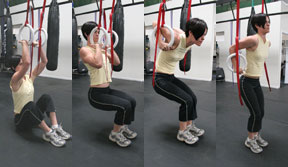
Pressing Initiation
For many who seemingly have the strength and technique for a strict muscle-up, the sticking point is the initiation of the press out of the bottom immediately following the transition. Most individuals perform bar and ring dips with a comparatively shallow range of motion and suddenly find themselves in a position from which they've never had to initiate a dip and are therefore unable to—don’t underestimate the increased difficulty associated with what may appear to be only a minor extension of the range of motion.
Development: Consistently perform your dips through a full range of motion—this should go without saying, but absolute full ROM dips are humblingly difficult even for those appearing strong in the movement and therefore widely avoided. Practice preferentially on rings and with the torso as upright as possible.
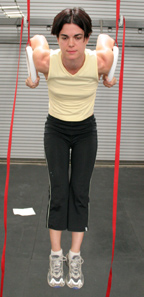
Finishing Extension
The rudimentary muscle-up forgoes full extension at the top as well as the bottom. Full extension requires complete elbow extension, active shoulders (in this position, depression of the scapulae—the opposite of a shrug), and partial external rotation of the arms (rotating the rings outward about 45 degrees). It's remarkably common even for individuals who can perform high numbers of successive ring dips for this final extension to be nearly unachievable initially.
Development: Perform static holds on the rings with active shoulders and tight, complete arm extension with the rings turned out. Like with the beginning extension position, partially support your weight with your feet as needed initially. Once static holds in this position have become reasonably easy, practice performing the last inch or two of a ring dip, finishing each rep with a strong, full extension and static hold. Eventually, this should become part of every ring dip you perform.
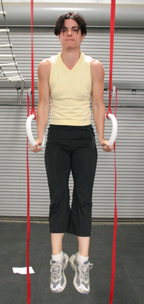
Other Considerations
The muscle-up is no joke. Obviously it demands a certain level of strength and stability—depending on your current abilities, the requisite degrees of each may be distant, but they're ultimately within reach. Continue developing your pulling and pressing strength—remember, this requires progressive overloading, not just the execution of a continually greater number of reps. Prior to developing the strength for a single bodyweight dip or pull-up, this can be achieved through negatives and/or partially leg-supported reps; following development of higher numbers of bodyweight dips and pull-ups, external weight can be added to the waist or held between the feet. Specificity of movements is important also—that is, false grip pull-ups and dips, both on rings and through absolutely full ranges of motion, will transfer better than any alternative movements.
Shoulder hypoflexibility is a limiting factor for some who would otherwise likely have the strength to perform a strict muscle-up. The combination of practicing the transition as described above and increasing the range of motion of your dips will likely be adequate for developing the requisite degree of flexibility. If you're impatient or want to be even more pro-active, include some specific shoulder stretching to your regular routine.
The Wrap
You now know far more about the muscle-up than you ever imagined necessary. Don't misinterpret this as belittlement of the rudimentary muscle-up—its achievement is cause for its very own celebration and pride. But don't make the mistake of considering it a final accomplishment—it should be a milestone along the path to ultimate studliness.
The rudimentary variation of the muscle-up excludes full extension at both the beginning and end of the movement—the two most difficult points in terms of strength. In addition, epic kips are employed. To clarify, the kip itself is not necessarily problematic—it's an excellent tool for helping develop the pull-up, for example, and has numerous benefits of its own. But in the case of the muscle-up, the kip is used to effectively bypass the transition from under to over—the most technically difficult aspect, and the development of which is necessary for a strict muscle-up. That being the case, continued performance of rudimentary muscle-ups without additional specific work prevents the development of the strict muscle-up.
Rudimentary Muscle-up vs Strict Muscle-up
Power Grab with a False Grip
The idea of optimizing power generation is a popular one—that is, performing a maximal amount of work in minimal time. In this context, the rudimentary muscle-up has found a welcoming home. The elimination of two inches each at the initial and end stages of the movement results in a relatively small reduction in total work because of the movement's unusually great range of motion—more than double that of a squat or pull-up. A reduction of 4 total inches of travel will reduce the work of a pull-up by over 17%, but will only reduce the work of a muscle-up by 9%.
More importantly, because time has a greater influence on power than the distance of travel, the reduced time for completion for the kipped muscle-up results in an enormous increase in power despite the reduction in work resulting from the reduced travel. A muscle-up with a range of motion shortened by 4 inches and performed in 2 second results in greater than 50% more power in comparison to a full range of motion muscle-up completed in 4 seconds.
What this means is fairly simple: depending on your individual objectives, the rudimentary muscle-up may have a place in your training. If your goal is achieving the highest power output possible—for example, for metabolic conditioning—clearly the rudimentary muscle-up is the better choice: it has the potential to deliver far more power than the strict muscle-up because of its high speed of execution.
So What's the Problem?
It's mathematically demonstrable that a muscle-up performed with greater speed, even with a reduced range of motion, results in far greater power output than a strict, full range of motion muscle-up, which by its nature requires more time to execute. So does it make sense to spend time and effort developing a strict muscle-up? That depends on your individual goals (which I assume confidently that you have clearly defined). If your only goals don't extend any further than repeatedly and indefinitely getting your metabolic rocks off, the rudimentary muscle-up will suffice. If, however, you have greater athletic aspirations, the inherent limitations of the rudimentary muscle-up will be an important consideration in your programming.
Once you've achieved a rudimentary muscle-up, performing the movement regularly will undoubtedly result in the ability to perform more and more of the same movement. Eventually, however, the stimulus will not be adequate for continued strength gains (unless you're continuously gaining bodyweight). Imagine deadlifting the same load for ten years—day one, that load may allow you to perform only a single rep. Eventually you'll likely be able to perform several successive reps—some day, you may be able to 100. But the ability to perform 100 reps of a given movement with given a load does not translate into the ability to lift a significantly greater load with that same movement (think Jazzercise practitioners—they can move a two-pound dumbbell about a million times). Beyond a certain threshold, strength development is replaced by local muscular endurance development. To continue developing strength, the resistance must be increased incrementally. This is the most basic concept of resistance training—progressive overload.
This idea results in a fitness progression resembling graphically a stair-step: that is, time must be spent developing a foundation of strength, then building on that strength base a greater degree of metabolic conditioning and stamina. Failure to develop the strength base unavoidably results in eventual stagnation.
The Point, Finally
All of that is simply to say that in order to continue to progress, the development of a strict muscle-up is a necessity—and the repeated performance of the rudimentary muscle-up will never produce this result. Just like you wouldn't (I hope) progress your deadlift though a spastic, limited range of motion, nor should you do so with your muscle-up; a requisite foundation for continued strength development in the movement is the development of the movement in its most precise form.
My personal recommendation is that people make learning the strict muscle-up a priority over achieving the rudimentary muscle-up—that is, they patiently develop both the requisite strength and technique for the strict movement instead of grasping for anything that even vaguely resembles it simply to have one more movement to throw into the metCon pool. The reasons are based on both motor learning and path-dependent transferability. It's very difficult to learn a new movement pattern that is very similar to an existing one: the transition movements of the two muscle-up variations are similar enough to cause neurological learning difficultly, but different enough that the movement pattern of the rudimentary muscle-up will not translate effectively to the strict muscle-up. And in terms of transferability, if you're capable of performing a strict muscle-up, you're without question also capable of performing a rudimentary muscle-up; the inverse, however, is clearly not true.
Developing the Big Kids' Muscle-up
Whether you have several rudimentary muscle-ups already or none at all, the progression to developing the Big Kids' Muscle-up is the same.
False Grip
Just about anyone will tell you the false grip is key number one for a muscle-up. If you're not yet familiar with the term, a false grip is the deep placement of the hand on the rings. A common mistake is gripping the ring on its side—this will result in an awkward support for the pressing portion of the movement. Be sure to place the false grip at the bottom of the ring—remember that this position should be the same you would use during a dip because that's exactly what you'll be transitioning into. Also, the use of chalk to keep the hands dry, particularly when performing multiple successive reps, will help immensely in maintaining the false grip.
Development: Perform static hangs with a perfect false grip. If you're unable to hang with your entire weight, support yourself with your feet initially and incrementally reduce the amount of support over time until it's no longer necessary.

Beginning Extension
As discussed above, the rudimentary muscle-up avoids full arm extension and shoulder opening at the beginning of the movement, and for good reasons—this position is both the most difficult in which to maintain a false grip and from which to initiate a pull-up. Full extension requires the hands be pronated (palms facing forward)—this is necessary to fully open the shoulders.
Development: Practicing the beginning extension can be accomplished in the same way described for the false grip—they are of course conveniently linked.

Transition
The transition of a strict muscle-up often seems far more complicated to many people than it actually is. Typically those who have the most difficulty learning it are those who are already capable of performing kipped muscle-ups, both because of the motor learning obstacles mentioned previously and the frustration that tends to develop when they abruptly go from being able to relatively easily get above the rings to repeatedly stalling below them.
The mechanics are simple—the elbows need to move from under to over the shoulders in order to transition from a pulling position to a pushing position. A common mistake is a staggered transition of the arms—"putting on a sweater." This allows the individual to partially unload one side in order to more easily move the corresponding elbow into position, which then allows them to support themselves at a higher elevation, making the transition of the second elbow shorter and easier. Not only does this look stupid, but it places the individual in a risky position from which it's easy to over rotate forward and do some potentially serious damage to a shoulder. Unlearning this habit is very difficult—the solution is to never develop it.
Learning the transition with barely adequate strength is difficult—this typically encourages a kip—sometimes subtle, more often not—to power through the sticking point. This is a mistake—as mentioned above, overpowering through the transition alters the mechanics enough to make the development of strict mechanics far more difficult. A much better option is to reduce the load to allow perfect technique practice.
Development: Lower your rings to a level at which you can comfortably grasp them with a false grip while seated on the floor, legs extended in front of you. In this case, don't worry about full extension—you're not working on developing that ability here and that extra effort will only take away from the practice of the movement on which we're focusing—but make sure to use the false grip.
From this position, pull the rings to below your armpits—keep them and your elbows as close to your body as possible—rotating them 90 degrees from the initially pronated hand position to a neutral one. At the peak of this pull, quickly flip your elbows back and up to a position above your shoulders. From here, press out, again keeping the rings as close to your body as possible and your elbows pointing backward.
If you struggle to press out after the transition, make sure you really know where your elbows are—they may be lower than it feels like. Get them as high as you can. Pushing the chest forward as if you're attempting to break a sheet of glass with your face (not recommended) will both elevate your elbows and increase the involvement of the chest musculature. Ideally and eventually, the strict muscle-up should be performed with as little forward lean as possible—this requires both greater strength and flexibility.

Pressing Initiation
For many who seemingly have the strength and technique for a strict muscle-up, the sticking point is the initiation of the press out of the bottom immediately following the transition. Most individuals perform bar and ring dips with a comparatively shallow range of motion and suddenly find themselves in a position from which they've never had to initiate a dip and are therefore unable to—don’t underestimate the increased difficulty associated with what may appear to be only a minor extension of the range of motion.
Development: Consistently perform your dips through a full range of motion—this should go without saying, but absolute full ROM dips are humblingly difficult even for those appearing strong in the movement and therefore widely avoided. Practice preferentially on rings and with the torso as upright as possible.

Finishing Extension
The rudimentary muscle-up forgoes full extension at the top as well as the bottom. Full extension requires complete elbow extension, active shoulders (in this position, depression of the scapulae—the opposite of a shrug), and partial external rotation of the arms (rotating the rings outward about 45 degrees). It's remarkably common even for individuals who can perform high numbers of successive ring dips for this final extension to be nearly unachievable initially.
Development: Perform static holds on the rings with active shoulders and tight, complete arm extension with the rings turned out. Like with the beginning extension position, partially support your weight with your feet as needed initially. Once static holds in this position have become reasonably easy, practice performing the last inch or two of a ring dip, finishing each rep with a strong, full extension and static hold. Eventually, this should become part of every ring dip you perform.

Other Considerations
The muscle-up is no joke. Obviously it demands a certain level of strength and stability—depending on your current abilities, the requisite degrees of each may be distant, but they're ultimately within reach. Continue developing your pulling and pressing strength—remember, this requires progressive overloading, not just the execution of a continually greater number of reps. Prior to developing the strength for a single bodyweight dip or pull-up, this can be achieved through negatives and/or partially leg-supported reps; following development of higher numbers of bodyweight dips and pull-ups, external weight can be added to the waist or held between the feet. Specificity of movements is important also—that is, false grip pull-ups and dips, both on rings and through absolutely full ranges of motion, will transfer better than any alternative movements.
Shoulder hypoflexibility is a limiting factor for some who would otherwise likely have the strength to perform a strict muscle-up. The combination of practicing the transition as described above and increasing the range of motion of your dips will likely be adequate for developing the requisite degree of flexibility. If you're impatient or want to be even more pro-active, include some specific shoulder stretching to your regular routine.
The Wrap
You now know far more about the muscle-up than you ever imagined necessary. Don't misinterpret this as belittlement of the rudimentary muscle-up—its achievement is cause for its very own celebration and pride. But don't make the mistake of considering it a final accomplishment—it should be a milestone along the path to ultimate studliness.
| Greg Everett is the owner of Catalyst Athletics, publisher of The Performance Menu Journal and author of Olympic Weightlifting: A Complete Guide for Athletes & Coaches, Olympic Weightlifting for Sports, and The Portable Greg Everett, and is the writer, director, producer, editor, etc of the independent documentary American Weightlifting. Follow him on Facebook here. |
Search Articles
Article Categories
Sort by Author
Sort by Issue & Date
Article Categories
Sort by Author
Sort by Issue & Date

